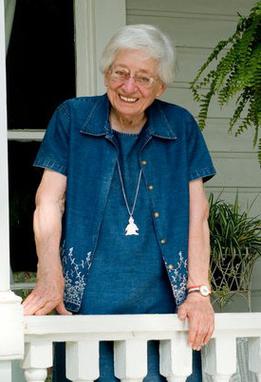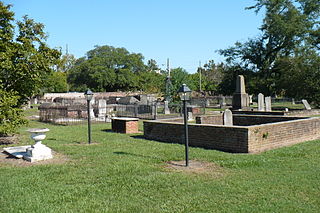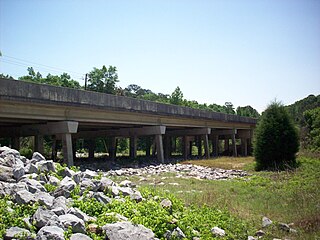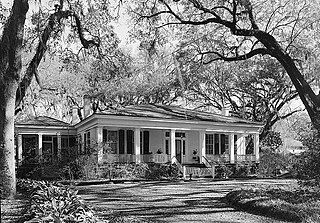
Quercus virginiana, also known as the southern live oak, is an evergreen oak tree endemic to the Southeastern United States. Though many other species are loosely called live oak, the southern live oak is particularly iconic of the Old South. Many very large and old specimens of live oak can be found today in the Deep South region of the United States.

Cahaba, also spelled Cahawba, was the first permanent state capital of Alabama from 1820 to 1825, and the county seat of Dallas County, Alabama until 1866. Located at the confluence of the Alabama and Cahaba rivers, it suffered regular seasonal flooding.

Kathryn Tucker Windham was an American storyteller, author, photographer, folklorist, and journalist. She was born in Selma, Alabama, and grew up in nearby Thomasville.

13 Alabama Ghosts and Jeffrey is a book first published in 1969 by folklorist Kathryn Tucker Windham and Margaret Gillis Figh. The book contains thirteen ghost stories from the U.S. state of Alabama. The book was the first in a series of seven Jeffrey books, most featuring ghost stories from a Southern state. Jeffrey in the book's title refers to a ghost that allegedly haunts Windham's home.

Mobile, Alabama during the American Civil War was an important port city on the Gulf of Mexico for the Confederate States of America. Mobile fell to the Union Army late in the war following successful attacks on the defenses of Mobile Bay by the Union Navy.

Bienville Square is a historic city park in the center of downtown Mobile, Alabama. Bienville Square was named for Mobile's founder, Jean-Baptiste Le Moyne, Sieur de Bienville. It takes up the entire block bordered by the streets of Dauphin, Saint Joseph, Saint Francis, and North Conception.

Church Street Graveyard is a historic city cemetery located in Mobile, Alabama. The cemetery is situated on 4 acres (1.6 ha) and is surrounded by a brick wall that dates to 1830. At the time that the cemetery was established it lay about a half mile away from most development, but it is now considered to be in downtown.

The Bragg–Mitchell Mansion, also known as the Bragg–Mitchell House, is a historic house museum in Mobile, Alabama. It was built in 1855 by Judge John Bragg and is one of the most photographed buildings in the city as well as one of the more popular tourist attractions. The house has been attributed to John's brother, a local Alabama architect, Alexander J. Bragg.

Catholic Cemetery, formerly known as the Stone Street Cemetery, is a historic 150-acre (61 ha) cemetery located in Mobile, Alabama. It was established in 1848 by Michael Portier, a native of Montbrison, France and the first Roman Catholic Bishop of Mobile. The cemetery contains roughly 18,000 burials and has plots dedicated to various Roman Catholic religious institutes, including the Brothers of the Sacred Heart, Daughters of Charity, Little Sisters of the Poor, and Sisters of Mercy. It was placed on the National Register of Historic Places on July 3, 1991 as a part of the Historic Roman Catholic Properties in Mobile Multiple Property Submission.

Sha'arai Shomayim Cemetery, also known as the Reformed Temple Jewish Cemetery, is a historic Jewish cemetery located in Mobile, Alabama, United States. It was established by Congregation Sha'arai Shomayim in 1876 after their previous cemetery, Jewish Rest in the adjacent Magnolia Cemetery, was filled to capacity. The cemetery is situated on 15 acres (6.1 ha) and is surrounded by a 19th-century cast-iron fence and live oak trees. The entrance is through an ornamental arched gate inscribed with the congregation name in Hebrew letters.

William Sketoe, Sr. was a Methodist minister from the south Alabama town of Newton, whose lynching there on December 3, 1864 gave birth to one of Alabama's best-known ghost stories. While locally-told stories of his life usually say that he was hanged on trumped-up charges of desertion from the Confederate Army, other sources show that he was killed for allegedly aiding pro-Union renegades in the area. Whatever the reason for his murder, a shallow hole dug beneath Sketoe's feet during the hanging ultimately led to stories about "the hole that won't stay filled." According to witnesses, this hole never disappeared—even after being filled numerous times—retaining its original dimensions for the next 125 years.

Georgia Cottage, also known as the Augusta Evans Wilson House, is a historic residence in Mobile, Alabama, United States. It was added to the National Register of Historic Places on September 14, 1972, based on its association with Augusta Jane Evans. She was one of the most popular American novelists of the nineteenth century and the first female author in the United States to earn over $100,000 for her work, but has been largely forgotten in recent times.

Sturdivant Hall, also known as the Watts-Parkman-Gillman Home, is a historic Greek Revival mansion and house museum in Selma, Alabama, United States. Completed in 1856, it was designed by Thomas Helm Lee for Colonel Edward T. Watts. It was added to the National Register of Historic Places on January 18, 1973, due to its architectural significance. Edward Vason Jones, known for his architectural work on the interiors at the White House during the 1960s and 70s, called it one of the finest Greek Revival antebellum mansions in the Southeast.

The Chapel of the Cross is a historic Episcopal church in the Mannsdale area of Madison, Mississippi. The brick structure was built circa 1850–52. It is noted for its Gothic Revival architecture, which draws heavily from 14th-century English country churches. It was added to the National Register of Historic Places in 1972.
The Eliza Battle was a Tombigbee River steamboat that ran a route between Columbus, Mississippi and Mobile, Alabama in the United States during the 1850s. She was destroyed in a fire on the river near modern Pennington, Alabama on March 1, 1858. It was the greatest maritime disaster in Tombigbee River history, with an estimated thirty-three people killed, out of roughly sixty passengers and a crew of forty-five. The disaster and its aftermath saw the Eliza Battle enter southwestern Alabama folklore as a ghost ship, with numerous purported sightings of the burning ship from just north of Pennington to Nanafalia downriver. The story of the disaster and associated folklore has been fictionalized in several published short stories, most notably in “The Phantom Steamboat of the Tombigbee” in 13 Alabama Ghosts and Jeffrey.

Rocky Hill Castle, also known simply as Rocky Hill, was a historic plantation and plantation house between Town Creek and Courtland, Alabama, United States. Once famed in Alabama for its architecture, it was an unusual mixing of neoclassical and picturesque aesthetics in one plantation complex. The house and tower suffered from neglect during much of the 20th century and were subsequently demolished in the 1960s. Much folklore surrounds the site, with Rocky Hill Castle being the subject of numerous ghost stories. The most notable story, "The Ghost of the Angry Architect", was published in Kathryn Tucker Windham and Margaret Gillis Figh's 1969 work 13 Alabama Ghosts and Jeffrey.

The Dr. John R. Drish House, also known simply as the Drish House, is a historic plantation house in Tuscaloosa, Alabama, United States. It is considered by state preservationists to be one of the most distinctive mixes of the Greek Revival and Italianate styles in Alabama. First recorded by the Historic American Buildings Survey in 1934, it was added to the Alabama Register of Landmarks and Heritage on July 31, 1975, and subsequently to the state's "Places in Peril" listing in 2006. It was listed as Jemison School-Drish House on the National Register of Historic Places in 2015.

James T. Staples, officially registered as the Jas. T. Staples and also known as the Big Jim, was a Tombigbee River sternwheel paddle steamer that ran a route between Mobile and Demopolis, Alabama, during the early 20th century. She was destroyed during 1913 in an explosion while docked on the Tombigbee roughly six miles (10 km) north of the current Coffeeville Lock and Dam. It was the last major maritime disaster involving a steamboat in Tombigbee River history. The disaster saw the ship enter southwestern Alabama folklore, with tales that its sinking had been foretold by supernatural occurrences.

Colonel McNeal House, also referred to as McNeal Place or the Ezekiel Polk McNeal House, is an Italianate mansion in Bolivar, Tennessee, part of Hardeman County, Tennessee. The home was built for Major Ezekiel Polk McNeal's and his wife after their only child, a teenage daughter named Priscilla, died in 1854. Initial construction began circa 1858 and the mansion was completed during the American Civil War circa 1861 - 1862. It was designed by architect Samuel Sloan. In National Register of Historic Places filings it is described as "the finest Italianate house in West Tennessee and among the most outstanding in the state." The residence is a two-story brick building with square cupola. The home is located on Bills Street and Union Street. It is part of the Bills-McNeal Historic District.





















